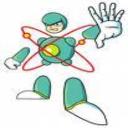Yahoo Answers is shutting down on May 4th, 2021 (Eastern Time) and beginning April 20th, 2021 (Eastern Time) the Yahoo Answers website will be in read-only mode. There will be no changes to other Yahoo properties or services, or your Yahoo account. You can find more information about the Yahoo Answers shutdown and how to download your data on this help page.
Trending News
I have some physics questions, can I get some help?
What is the maximum speed with which a 1200-kg car can round a turn of radius 81.0 m on a flat road if the coefficient of static friction between tires and road is 0.60?
How large must the coefficient of static friction be between the tires and the road if a car is to round a level curve of radius 135 m at a speed of 115 km/h ?
What is the magnitude of the acceleration of a speck of clay on the edge of a potter's wheel turning at 47 rpm (revolutions per minute) if the wheel's diameter is 39 cm ?
A horizontal force of 340 N is exerted on a 2.5-kg ball as it rotates (at arm's length) uniformly in a horizontal circle of radius 0.90 m.Calculate the speed of the ball.
A child sitting 1.60 m from the center of a merry-go-round moves with a speed of 1.65 m/s . Calculate the centripetal acceleration of the child.
Calculate the net horizontal force exerted on the child. (mass = 24.5 kg )
1 Answer
- electron1Lv 72 years agoFavorite Answer
In the first two problems, the centripetal force is equal to the friction force.
Fc = m * v^2 ÷ r
Ff = μ * m * g
m * v^2 ÷ r = μ * m * g
v^2 = r * μ * g
v = √( r * μ * g)
For the first problem, v = √(81 * 0.6 * 9.8) = √476.28
This is approximately 21.8 m/s.
How large must the coefficient of static friction be between the tires and the road if a car is to round a
level curve of radius 135 m at a speed of 115 km/h ?
One km = 1000 meters
One hour = 3600 seconds
One km/h = 1000/3600 = 5/18 m/s
v = 115 * 5/18 = 575/18
This is approximately 31.9 m/s.
v^2 = r * μ * g
μ = v^2 ÷ (r * g)
μ = (57.5/18)^2 ÷ 1,323
This is approximately 0.77.
What is the magnitude of the acceleration of a speck of clay on the edge of a potter's wheel turning at 47 rpm (revolutions per minute) if the wheel's diameter is 39 cm ?
During one minute, the speck of clay moves a distance that is equal to the circumference of a circle.
d = 0.39 * π
Total distance = 47 * 0.39 * π = 18.33* π
One minute is 60 seconds.
v = 18.33* π ÷ 60 = 0.3055 * π
The velocity is approximately 0.097 m/s.
Centripetal acceleration = v^2 ÷ r = (0.3055 * π)^2 ÷ 0.195
The velocity is approximately 4.72 m/s^2.
A horizontal force of 340 N is exerted on a 2.5-kg ball as it rotates (at arm's length) uniformly in a horizontal circle of radius 0.90 m.Calculate the speed of the ball.
Fc = 340 ÷ 2.5 = 136 m/s
Fc = v^2 ÷ 0.9
v^2 ÷ 0.9 = 136
v = √(122.4
The velocity is approximately 11.1 m/s
A child sitting 1.60 m from the center of a merry-go-round moves with a speed of 1.65 m/s . Calculate the centripetal acceleration of the child.
Centripetal acceleration = 1.65^2 ÷ 1.60
This is approximately 1.7 m/s^2
Calculate the net horizontal force exerted on the child. (mass = 24.5 kg )
This is the centripetal force,
Fc = 24.5 * (1.65^2 ÷ 1.60)
This is approximately 41.7 N. I hope this is helpful for you in the future.




